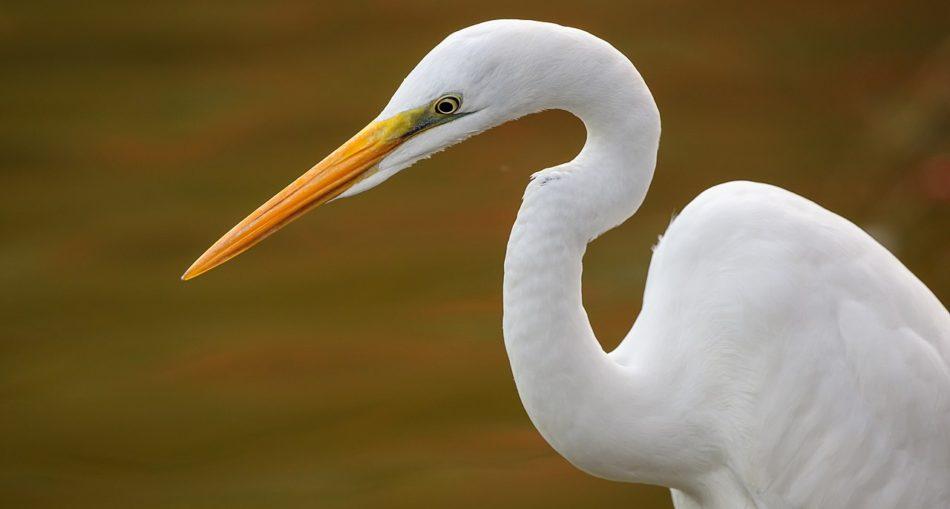The Egret is slender and graceful heron and I have sometimes wrongly classified it as a ‘stork’ when I was younger. These animals are a delight to look at as they hunt; their long necks gently moving back and forth as they walk alongside the beds of small rivers or trenches, stalking their prey quietly and patiently, strategically waiting for the right moment to strike to snatch up a hearty meal at the right moment. I have always loved passing by and seeing these birds, sometimes I would completely zone out while looking at them; their grace and patience is captivating.
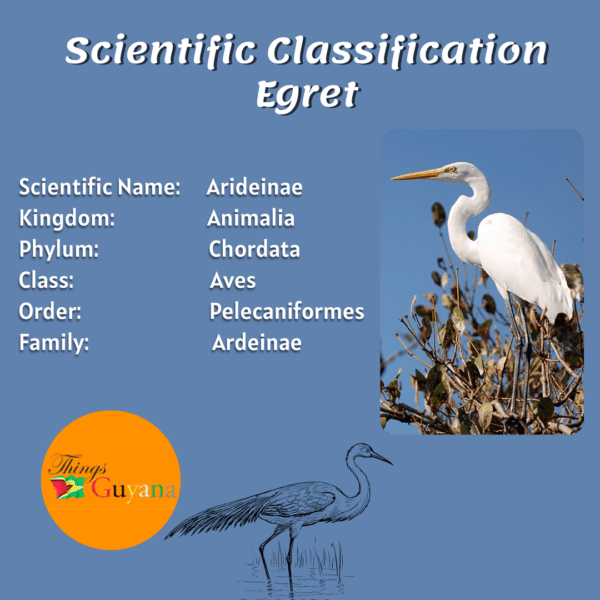
Description
The plunge of the egret is white and fluffy, their bills are slightly different from their counterparts, and they bear a striking yellow-and-pink bill. As their name suggests, the size of these birds is in a safe middle ground compared to the giant egret and the little egret, from 22 to 28 inches in length and a wingspan of 41 to 45 inches, making them incredible, silent flyers. Their slender, black legs allow them to wade through shallow water as they hunt. Both males and females have very similar features with the exception of males being slightly more prominent. Egrets have comb-like serrations on the edges of their middle claws, which help to preen feathers inaccessible by their bills.
Habitat
Egrets are part of the heron family and can be found near water by marshes/swamps. They can be found dwelling alongside ibises and other herons.
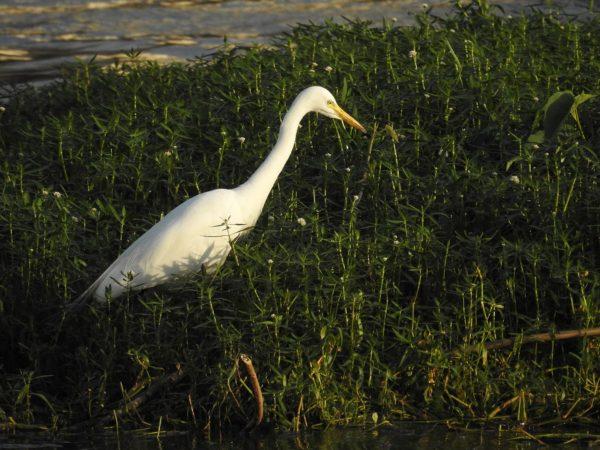
Photo of an Egret in a marsh. Photo Source: https://en.wikipedia.org/wiki/Intermediate_egret#/media/File:Intermediate_Egret_DSCN1932.jpg
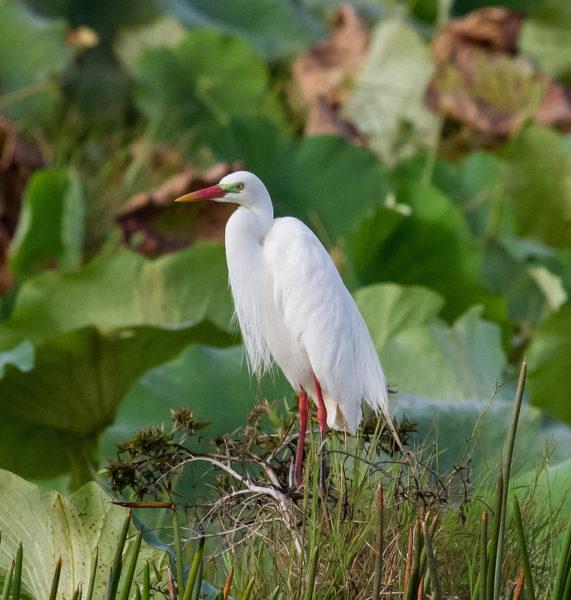
Photo of an egret in its habitat. Photo Source: https://en.wikipedia.org/wiki/Intermediate_egret#/media/File:Intermediate_Egret_in_breeding_plumage.1_-_Fogg_Dam_-_Middle_Point_-_Northern_Territory_-_Australia.jpg
Diet
Mostly fish. Aside from fish, also eats crustaceans, frogs, salamanders, snakes, and aquatic insects. In open fields may catch grasshoppers and rodents.
These birds would stand methodically next to shallow waters by standing or walking in shallow water, waiting for fish to come near, then catching them with a rapid thrust of the bill. May feed in flocks or in association with other herons, cormorants, and ibises, sometimes stealing food from smaller birds. Also forages in open fields, sometimes around cattle.
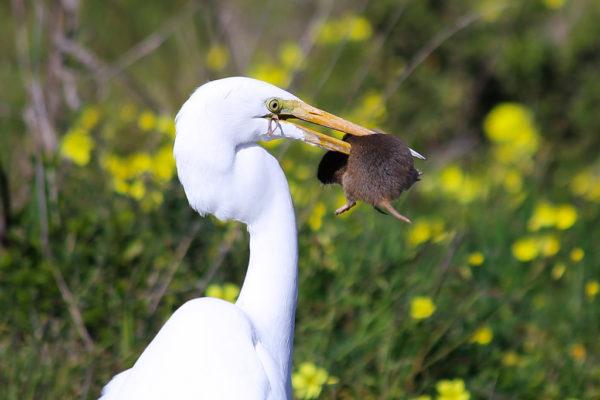
Photo of an egret eating a mouse. Photo Source: https://www.flickr.com/photos/parksjd/8504531790
Communication
Great Egrets make dry, croaking sounds, nasal squeals, and other harsh calls. They are particularly vocal during breeding season as they go about establishing territories, courting, forming pairs, and maintaining pair bonds.
Here is a video of the sound that egrets make:
Reproduction
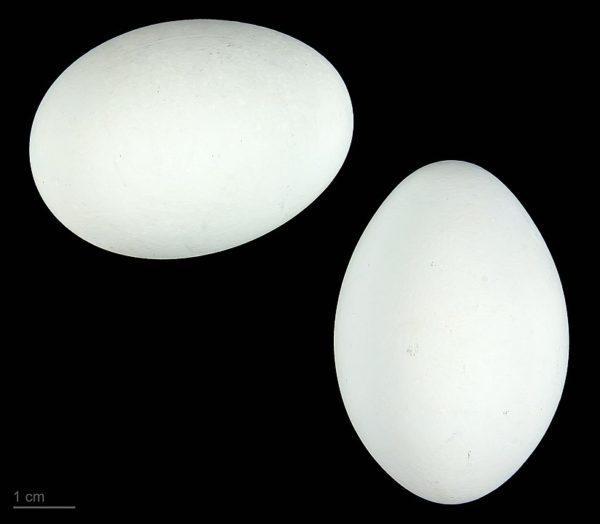
Photo of the egg of an egret. Photo Source: https://en.wikipedia.org/wiki/Intermediate_egret#/media/File:Ardea_intermedia_brachyrhyncha_MHNT.ZOO.2010.11.52.9.jpg
Probably between two and three years old is when they first reproduce. Nests are in colonies most of the time but occasionally in lone pairs. Wading birds such as cormorants and anhingas are frequently mixed in. Egrets prefer to nest high in mixed colonies.
The male chooses a nesting location and performs there, initially driving out all other birds before courting females later. Calling, a circular display flight, and stretching the neck up with the bill pointed upward are examples of courtship behaviours. The eggs are pale green in colour
and smooth. After 24 to 27 days the eggs hatch and both parents incubate the eggs. Pinfeathers may appear on the chicks as early as 4 days old and the young are able to leave the nest at 24 days old, although they return to be fed. Both parents feed their young, by regurgitation. Young may clamber out of the nest at 3 weeks, able to fly at 6-7 weeks.
Symbolism
Independence – Egrets are solitary animals and are able to take care of themselves although they have learned to adapt to larger groups. Egrets can teach us that we can rely on ourselves instead of others. They are a symbol of freedom and independence.
Patience – They are also a symbol of patience. If you have ever noticed an egret hunt you would have observed how calmly and carefully they stalk their prey and instead of rushing in to grab a fish they would cautiously make their way closer to the water, seemingly safe and trusting, the fish does not see the egret as a threat. As such, they are able to gobble them (the fishes) up when they least expect it.
Purity – They are also a symbol of purity given their white colour and most cultures would regard this as having a divine status.
If you ever see these beautiful birds wading through the water, I suggest you take a moment to admire their skilled and elegant way of hunting.
Here’s a Joke: What did egret say to his mom when she found out he cheated on the test? “Mom, I’m sorry, I really egret what I did.” (Yes, you can roll your eyes at that joke)
References:
https://www.audubon.org/field-guide/bird/great-egret
https://en.wikipedia.org/wiki/Intermediate_egret

